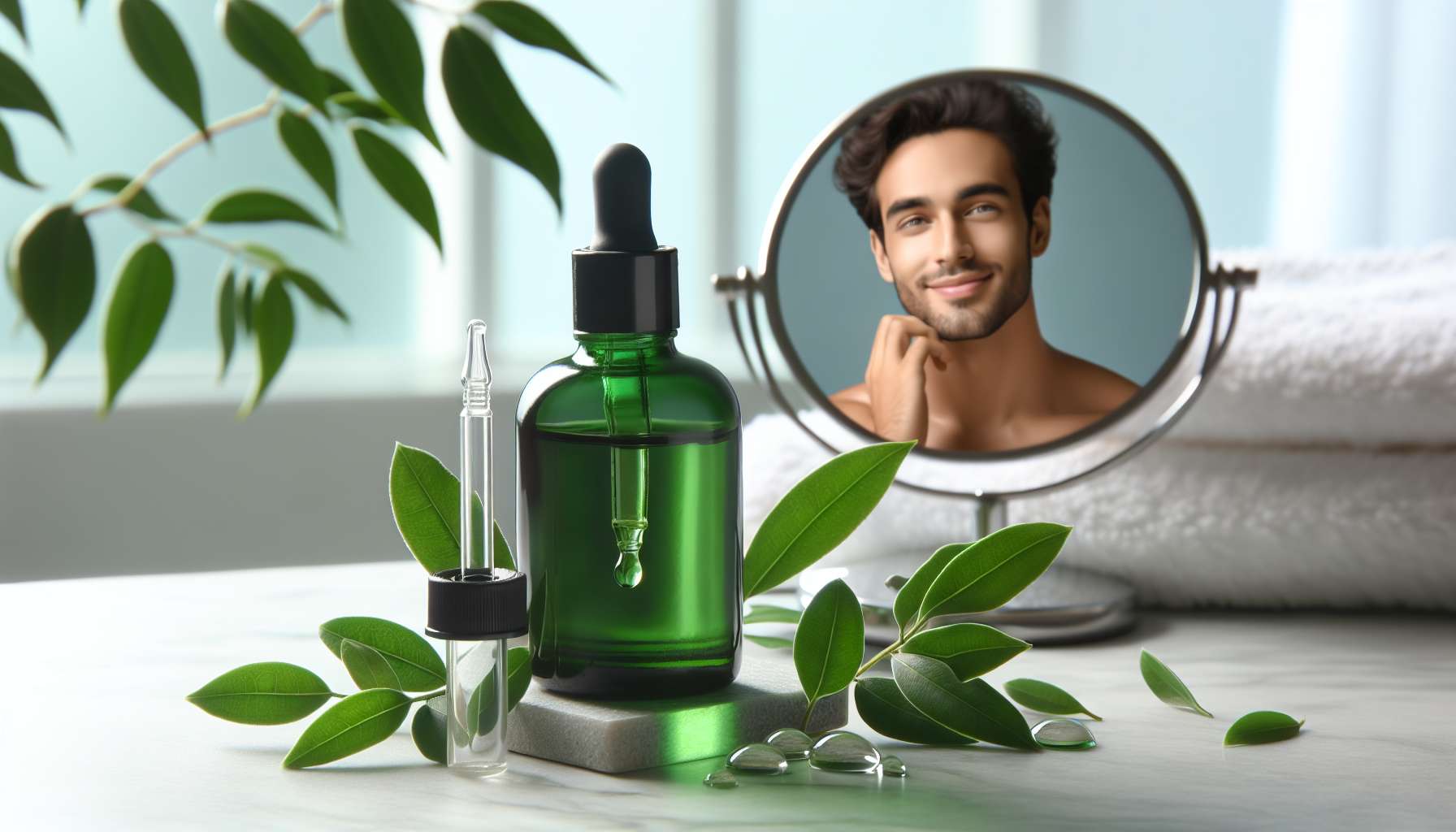Tea Tree Oil Acne Spot Treatment: A Comprehensive Guide
Acne can be a frustrating and stubborn skin condition that affects many individuals, regardless of age or gender. From over-the-counter products to prescription medications, the market is flooded with various treatments promising to banish those pesky pimples. However, one natural remedy that has gained popularity in recent years is tea tree oil acne spot treatment. This essential oil is renowned for its antibacterial and anti-inflammatory properties, making it a promising solution for targeting acne and blemishes. In this comprehensive guide, we will delve into the world of tea tree oil acne spot treatment, exploring its benefits, applications, and potential drawbacks. So, sit back, relax, and let’s uncover the magic of tea tree oil!
The Origins of Tea Tree Oil
Tea tree oil, also known as melaleuca oil, is derived from the leaves of the tea tree plant (Melaleuca alternifolia), which is native to Australia. The indigenous people of Australia, the Aboriginals, have long used tea tree oil for its medicinal properties. They would crush the leaves of the tea tree plant and apply them to wounds, cuts, and skin infections to promote healing. The oil was later distilled from the leaves, creating a potent solution that could combat various skin conditions.
Tea tree oil gained global recognition in the early 1920s when Australian chemist Arthur Penfold conducted research on its antiseptic properties. During World War II, tea tree oil was included in the first aid kits of Australian soldiers to treat wounds and infections. Since then, tea tree oil has become a staple in natural skincare products, thanks to its powerful antibacterial, antifungal, and anti-inflammatory properties.
The Science Behind Tea Tree Oil’s Acne-Fighting Abilities
Acne is primarily caused by the overproduction of sebum, a natural oil produced by the skin, along with the accumulation of dead skin cells and the presence of acne-causing bacteria. Tea tree oil is believed to combat acne through several mechanisms:
1. Antibacterial Properties: Tea tree oil contains compounds such as terpinen-4-ol that exhibit strong antibacterial properties. These compounds can penetrate the skin and target acne-causing bacteria, such as Propionibacterium acnes, reducing inflammation and preventing new breakouts.
2. Anti-Inflammatory Effects: Inflammation plays a significant role in the development and exacerbation of acne. Tea tree oil has anti-inflammatory properties that can help soothe redness, swelling, and irritation associated with acne lesions.
3. Sebum Regulation: Tea tree oil may help regulate sebum production in the skin, preventing excess oil from clogging pores and leading to acne development.
Studies have shown that tea tree oil can be as effective as benzoyl peroxide, a common ingredient in acne treatments, but with fewer side effects. This natural alternative has garnered attention for its ability to target acne without causing dryness, peeling, or irritation commonly associated with harsh acne medications.
How to Use Tea Tree Oil for Acne Spot Treatment
When using tea tree oil for acne spot treatment, it is essential to dilute the oil properly to prevent skin irritation. Here’s a simple guide to incorporating tea tree oil into your skincare routine:
1. Choose a Carrier Oil: Tea tree oil is highly concentrated and can be too harsh on the skin when applied directly. Mix a few drops of tea tree oil with a carrier oil, such as coconut oil or jojoba oil, to dilute it and reduce the risk of irritation.
2. Perform a Patch Test: Before applying tea tree oil to your face, do a patch test on a small area of skin to check for any allergic reactions or sensitivity.
3. Cleanse Your Skin: Start by cleansing your face with a gentle cleanser to remove dirt, oil, and impurities from the skin.
4. Apply the Diluted Tea Tree Oil: Using a cotton swab or clean fingertips, apply the diluted tea tree oil directly to the affected areas or individual blemishes. Avoid applying it to large areas of the skin, as it may cause dryness or irritation.
5. Follow with Moisturizer: Once the tea tree oil has been applied, follow up with a lightweight, non-comedogenic moisturizer to hydrate the skin and maintain its balance.
6. Use Sparingly: Tea tree oil is potent, so a little goes a long way. Start with a small amount and gradually increase the concentration if needed.
It’s essential to note that tea tree oil may not be suitable for everyone, especially those with sensitive skin or allergies. If you experience any adverse reactions, discontinue use and consult a dermatologist.
Expert Opinions on Tea Tree Oil Acne Spot Treatment
Many skincare experts and dermatologists have weighed in on the effectiveness of tea tree oil for acne spot treatment. Dr. Ava Shamban, a board-certified dermatologist, notes that tea tree oil can be a valuable addition to an acne treatment regimen, particularly for those looking for a natural alternative to traditional acne medications.
Dr. Joshua Zeichner, a dermatologist and Director of Cosmetic and Clinical Research in Dermatology at Mount Sinai Hospital in New York City, recommends using tea tree oil in moderation and combining it with other acne-fighting ingredients, such as salicylic acid or benzoyl peroxide, for optimal results.
Overall, experts agree that tea tree oil can be an effective option for targeting acne spots and blemishes, but it should be used judiciously and in conjunction with a well-rounded skincare routine.
Common Misconceptions About Tea Tree Oil
Despite its popularity as a natural remedy for acne, tea tree oil is not without its misconceptions. One common misconception is that tea tree oil can be used undiluted on the skin. This is not recommended, as the concentrated nature of tea tree oil can cause skin irritation, redness, and even chemical burns.
Another misconception is that tea tree oil is a miracle cure for acne and will work overnight. While tea tree oil can help reduce inflammation and target acne-causing bacteria, it is not a quick fix and may take time to show noticeable results. Consistency and patience are key when using tea tree oil for acne spot treatment.
Comparative Analysis: Tea Tree Oil vs. Other Acne Treatments
When comparing tea tree oil to other acne treatments, such as benzoyl peroxide, salicylic acid, or prescription medications, there are several factors to consider:
1. Natural vs. Synthetic: Tea tree oil is a natural remedy derived from plant sources, whereas many traditional acne treatments contain synthetic ingredients. Some individuals prefer natural products for their skincare routines due to concerns about potential side effects or harsh chemicals.
2. Side Effects: Tea tree oil is generally well-tolerated by most individuals, with minimal side effects. In contrast, benzoyl peroxide and other acne medications can cause dryness, redness, and peeling, especially in sensitive skin types.
3. Acne Severity: The effectiveness of tea tree oil may vary depending on the severity of acne. Mild to moderate acne may respond well to tea tree oil spot treatment, while severe acne may require stronger prescription medications for effective management.
Ultimately, the choice between tea tree oil and other acne treatments depends on individual preferences, skin type, and the specific needs of the skin. It may be beneficial to consult a dermatologist to determine the most suitable treatment plan for acne.
FAQs About Tea Tree Oil Acne Spot Treatment
1. Can tea tree oil be used on sensitive skin?
While tea tree oil is generally considered safe for most skin types, individuals with sensitive skin may experience irritation or allergic reactions. It is recommended to perform a patch test before applying tea tree oil to the face.
2. How long does it take to see results with tea tree oil spot treatment?
The timeline for seeing results with tea tree oil spot treatment can vary depending on the individual’s skin type, severity of acne, and consistency of use. Some individuals may notice improvement within a few days, while others may require several weeks to see visible changes.
3. Can tea tree oil be used as a preventative measure for acne?
Tea tree oil may help reduce the risk of future breakouts by targeting acne-causing bacteria and regulating sebum production. Regular use of tea tree oil spot treatment can be a preventive measure against new blemishes.
To Wrap Things Up
Tea tree oil acne spot treatment is a natural and effective remedy for targeting acne spots and blemishes. With its antibacterial, anti-inflammatory, and sebum-regulating properties, tea tree oil can help combat acne without the harsh side effects of traditional acne medications. By incorporating tea tree oil into your skincare routine in a safe and cautious manner, you can reap the benefits of this powerful essential oil. Remember to consult a dermatologist if you have any concerns or experience adverse reactions. So, why not give tea tree oil a try and say goodbye to acne woes?




